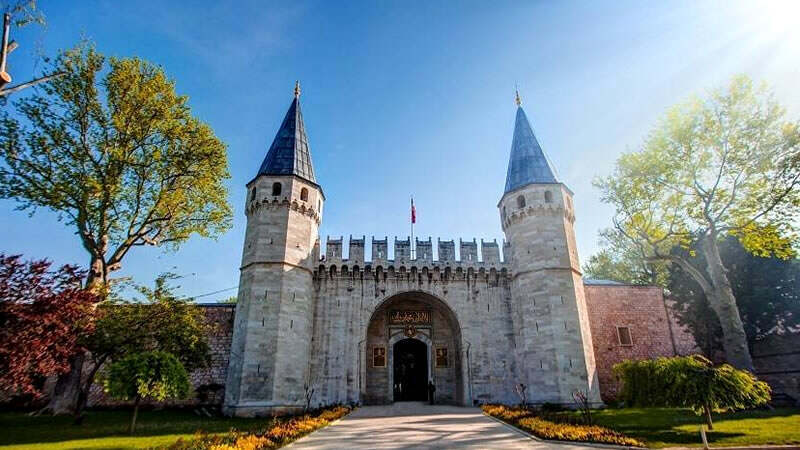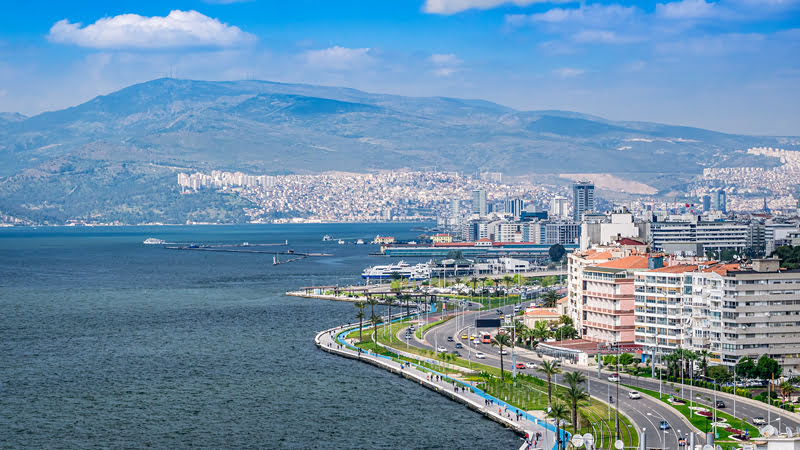Dolmabahce Palace - The Majestic Face of Istanbul

Located on the European side of the Bosphorus in Istanbul, Dolmabahce Palace is one of the most magnificent witnesses to the Ottoman Empire's final era. Built during the city's westernization period, this palace is considered one of the most splendid works of Ottoman architecture. With its rich historical background, grand architecture, and cultural significance, Dolmabahce Palace is a must-visit destination for both local and international tourists in Istanbul.
Dolmabahce Palace is regarded as one of the most important symbols of the Ottoman Empire's modernization and openness to the West. Commissioned by Sultan Abdulmejid I, its construction began in 1843 and was completed in 1856 after approximately 13 years. This period marked a transition where the Ottomans embraced Western styles, moving away from traditional architecture. The area where the palace now stands was originally a dockyard for the Ottoman navy and later filled in and expanded, hence the name "Dolmabahce," meaning "filled-in garden."
Reflecting the influences of Baroque, Rococo, and Neoclassical styles, Dolmabahce Palace combines Western architectural elements with the intricate craftsmanship of the Ottoman Empire, creating a unique masterpiece. The exterior facades and interior spaces blend the refined and flamboyant Western styles with the detailed Ottoman artistry. The palace’s spacious halls, massive chandeliers, and elaborate decorations embody the grandeur of the era and the Ottoman desire for modernization.
Upon completion, Dolmabahce Palace became the new administrative center of the Ottoman Empire. Sultans conducted state affairs, ceremonies, and diplomatic meetings within its walls. Representing the empire's orientation towards the West, the palace symbolized both its power and splendor. Distinguished guests, including statesmen, diplomats, and prominent figures from Europe, were hosted here.
In the late Ottoman period, Dolmabahce Palace played a key role in many critical decisions. Following the proclamation of the Republic, the palace maintained its significance as Mustafa Kemal Ataturk, the founder of the Republic of Türkiye, used it during his visits to Istanbul. Ataturk spent his final days here and passed away in Dolmabahce Palace on November 10, 1938. This emotional connection to Ataturk holds immense importance in Türkiye history and for the Türkiye people.
Dolmabahce Palace illuminates not only the Ottoman Empire's final chapters but also the early years of the Republic of Türkiye. Today, the palace serves as an invaluable historical and cultural heritage site, welcoming both local and foreign visitors eager to experience the grandeur of the Ottoman past up close.
Spanning an area of 110,000 square meters, Dolmabahce Palace boasts 285 rooms, 46 halls, 6 baths, and 68 toilets. Known for its grandeur, the palace captivates with its luxurious interior, featuring valuable materials. The Ceremonial Hall, with its 36-meter-high dome, is the largest hall in the palace and was used for official receptions of Ottoman sultans. The centerpiece of this hall is the enormous 4.5-ton crystal chandelier, one of the largest in the world, gifted by Queen Victoria of England.
One of the most significant rooms in the palace is the chamber where Mustafa Kemal Ataturk took his last breath. This room symbolizes the legacy of the Republic values Ataturk left to the Türkiye nation and continues to draw great interest from visitors. The room is open to the public today as a site of historical and national importance. The palace also exhibits numerous artistic and cultural treasures, including gold leaf decorations, paintings by European artists, and handmade carpets from the Ottoman era.
Dolmabahce Palace is situated in Istanbul's Besiktas district along the Bosphorus. The palace is easily accessible by both public transportation and private vehicles.
For those using public transportation, the Kabatas tram line offers a convenient option. From Kabatas station, the palace is just a short walk away. Alternatively, minibusses or buses from Taksim Square heading towards Besiktas can be used. For visitors preferring not to use public transport, Istanbul car rental services provide a practical solution. If you plan to drive, the palace offers parking facilities, ensuring a hassle-free visit. You can also reach the palace by walking along the Bosphorus or via sea routes to Besiktas pier. Ferry services offer an alternative for those wishing to explore Istanbul from the water.
Visitors to Dolmabahce Palace can also explore nearby tourist attractions. Just a few minutes’ walk from the palace is Besiktas Square, a vibrant hub with cafes, restaurants, and shops. The square is an ideal spot to relax and enjoy the city’s lively atmosphere. Close by, the Istanbul Naval Museum showcases artifacts from the Ottoman navy and provides a comprehensive look at maritime history.
For those seeking a nature retreat after their palace visit, Yildiz Park, located nearby, is a perfect escape. This park, especially famous during spring for its blooming trees and peaceful environment, offers scenic walks accompanied by breathtaking views of the Bosphorus.
Dolmabahce Palace hosts a variety of cultural events throughout the year. Classical music concerts held in the palace’s majestic halls, such as the Ceremonial Hall, are among the most popular activities. These concerts combine history and art in a mesmerizing setting.
Additionally, periodic historical exhibitions featuring Ottoman artworks and objects reflecting palace life are presented at Dolmabahce Palace. These exhibitions offer visitors a glimpse into the artistic and cultural heritage of the Ottoman era.
The palace’s gardens are just as captivating as its interior. Situated along the Bosphorus, the gardens offer a serene atmosphere in harmony with the historical structure. For photography enthusiasts, the garden provides stunning views, especially at sunset. The silhouette of the historic palace blended with the blue waters of the Bosphorus creates an unforgettable memory.
The preservation of Dolmabahce Palace has been made possible through meticulous restoration efforts over many years. These efforts aim to maintain the historical integrity of both the interior and exterior of the palace. As a reflection of Ottoman art and architecture, the preservation of this structure holds immense significance as a part of world heritage.
The best time to visit Dolmabahce Palace is during the spring and summer months when its gardens are at their most vibrant. Weekday mornings are ideal for those seeking a quieter experience. Weekends, however, tend to be crowded, so visiting early in the day is recommended.
Dolmabahce Palace leaves a lasting impression not only with its architecture but also with its profound history. Hosting the most glorious periods of the Ottoman Empire, the palace also preserves the memories of Ataturk. Walking through its magnificent halls feels like a journey through history.
A must-see destination for tourists, Dolmabahce Palace is perfect for discovering Istanbul’s rich history and culture. Located against the backdrop of the Bosphorus, it offers unparalleled views, especially during sunset. After exploring the palace, visitors can relax in nearby cafes and restaurants, enjoying the unique ambiance of Istanbul.
A visit to Dolmabahce Palace provides an unforgettable experience, shedding light on Istanbul's magnificent history. As one of the greatest symbols of Ottoman westernization efforts, the palace offers an enchanting architectural and historical journey.
The History of Dolmabahce Palace
Dolmabahce Palace is regarded as one of the most important symbols of the Ottoman Empire's modernization and openness to the West. Commissioned by Sultan Abdulmejid I, its construction began in 1843 and was completed in 1856 after approximately 13 years. This period marked a transition where the Ottomans embraced Western styles, moving away from traditional architecture. The area where the palace now stands was originally a dockyard for the Ottoman navy and later filled in and expanded, hence the name "Dolmabahce," meaning "filled-in garden."
Reflecting the influences of Baroque, Rococo, and Neoclassical styles, Dolmabahce Palace combines Western architectural elements with the intricate craftsmanship of the Ottoman Empire, creating a unique masterpiece. The exterior facades and interior spaces blend the refined and flamboyant Western styles with the detailed Ottoman artistry. The palace’s spacious halls, massive chandeliers, and elaborate decorations embody the grandeur of the era and the Ottoman desire for modernization.
Upon completion, Dolmabahce Palace became the new administrative center of the Ottoman Empire. Sultans conducted state affairs, ceremonies, and diplomatic meetings within its walls. Representing the empire's orientation towards the West, the palace symbolized both its power and splendor. Distinguished guests, including statesmen, diplomats, and prominent figures from Europe, were hosted here.
In the late Ottoman period, Dolmabahce Palace played a key role in many critical decisions. Following the proclamation of the Republic, the palace maintained its significance as Mustafa Kemal Ataturk, the founder of the Republic of Türkiye, used it during his visits to Istanbul. Ataturk spent his final days here and passed away in Dolmabahce Palace on November 10, 1938. This emotional connection to Ataturk holds immense importance in Türkiye history and for the Türkiye people.
Dolmabahce Palace illuminates not only the Ottoman Empire's final chapters but also the early years of the Republic of Türkiye. Today, the palace serves as an invaluable historical and cultural heritage site, welcoming both local and foreign visitors eager to experience the grandeur of the Ottoman past up close.
Architectural Features of Dolmabahce Palace
Spanning an area of 110,000 square meters, Dolmabahce Palace boasts 285 rooms, 46 halls, 6 baths, and 68 toilets. Known for its grandeur, the palace captivates with its luxurious interior, featuring valuable materials. The Ceremonial Hall, with its 36-meter-high dome, is the largest hall in the palace and was used for official receptions of Ottoman sultans. The centerpiece of this hall is the enormous 4.5-ton crystal chandelier, one of the largest in the world, gifted by Queen Victoria of England.
One of the most significant rooms in the palace is the chamber where Mustafa Kemal Ataturk took his last breath. This room symbolizes the legacy of the Republic values Ataturk left to the Türkiye nation and continues to draw great interest from visitors. The room is open to the public today as a site of historical and national importance. The palace also exhibits numerous artistic and cultural treasures, including gold leaf decorations, paintings by European artists, and handmade carpets from the Ottoman era.
How to Get to Dolmabahce Palace
Dolmabahce Palace is situated in Istanbul's Besiktas district along the Bosphorus. The palace is easily accessible by both public transportation and private vehicles.
For those using public transportation, the Kabatas tram line offers a convenient option. From Kabatas station, the palace is just a short walk away. Alternatively, minibusses or buses from Taksim Square heading towards Besiktas can be used. For visitors preferring not to use public transport, Istanbul car rental services provide a practical solution. If you plan to drive, the palace offers parking facilities, ensuring a hassle-free visit. You can also reach the palace by walking along the Bosphorus or via sea routes to Besiktas pier. Ferry services offer an alternative for those wishing to explore Istanbul from the water.
Tourist Attractions Around Dolmabahce Palace
Visitors to Dolmabahce Palace can also explore nearby tourist attractions. Just a few minutes’ walk from the palace is Besiktas Square, a vibrant hub with cafes, restaurants, and shops. The square is an ideal spot to relax and enjoy the city’s lively atmosphere. Close by, the Istanbul Naval Museum showcases artifacts from the Ottoman navy and provides a comprehensive look at maritime history.
For those seeking a nature retreat after their palace visit, Yildiz Park, located nearby, is a perfect escape. This park, especially famous during spring for its blooming trees and peaceful environment, offers scenic walks accompanied by breathtaking views of the Bosphorus.
Activities Awaiting Visitors at Dolmabahce Palace
Dolmabahce Palace hosts a variety of cultural events throughout the year. Classical music concerts held in the palace’s majestic halls, such as the Ceremonial Hall, are among the most popular activities. These concerts combine history and art in a mesmerizing setting.
Additionally, periodic historical exhibitions featuring Ottoman artworks and objects reflecting palace life are presented at Dolmabahce Palace. These exhibitions offer visitors a glimpse into the artistic and cultural heritage of the Ottoman era.
The Gardens and Bosphorus Views of Dolmabahce Palace
The palace’s gardens are just as captivating as its interior. Situated along the Bosphorus, the gardens offer a serene atmosphere in harmony with the historical structure. For photography enthusiasts, the garden provides stunning views, especially at sunset. The silhouette of the historic palace blended with the blue waters of the Bosphorus creates an unforgettable memory.
Restoration and Preservation of Dolmabahce Palace
The preservation of Dolmabahce Palace has been made possible through meticulous restoration efforts over many years. These efforts aim to maintain the historical integrity of both the interior and exterior of the palace. As a reflection of Ottoman art and architecture, the preservation of this structure holds immense significance as a part of world heritage.
The Best Times to Visit Dolmabahce Palace
The best time to visit Dolmabahce Palace is during the spring and summer months when its gardens are at their most vibrant. Weekday mornings are ideal for those seeking a quieter experience. Weekends, however, tend to be crowded, so visiting early in the day is recommended.
An Unforgettable Experience at Dolmabahce Palace
Dolmabahce Palace leaves a lasting impression not only with its architecture but also with its profound history. Hosting the most glorious periods of the Ottoman Empire, the palace also preserves the memories of Ataturk. Walking through its magnificent halls feels like a journey through history.
A must-see destination for tourists, Dolmabahce Palace is perfect for discovering Istanbul’s rich history and culture. Located against the backdrop of the Bosphorus, it offers unparalleled views, especially during sunset. After exploring the palace, visitors can relax in nearby cafes and restaurants, enjoying the unique ambiance of Istanbul.
A visit to Dolmabahce Palace provides an unforgettable experience, shedding light on Istanbul's magnificent history. As one of the greatest symbols of Ottoman westernization efforts, the palace offers an enchanting architectural and historical journey.


















































